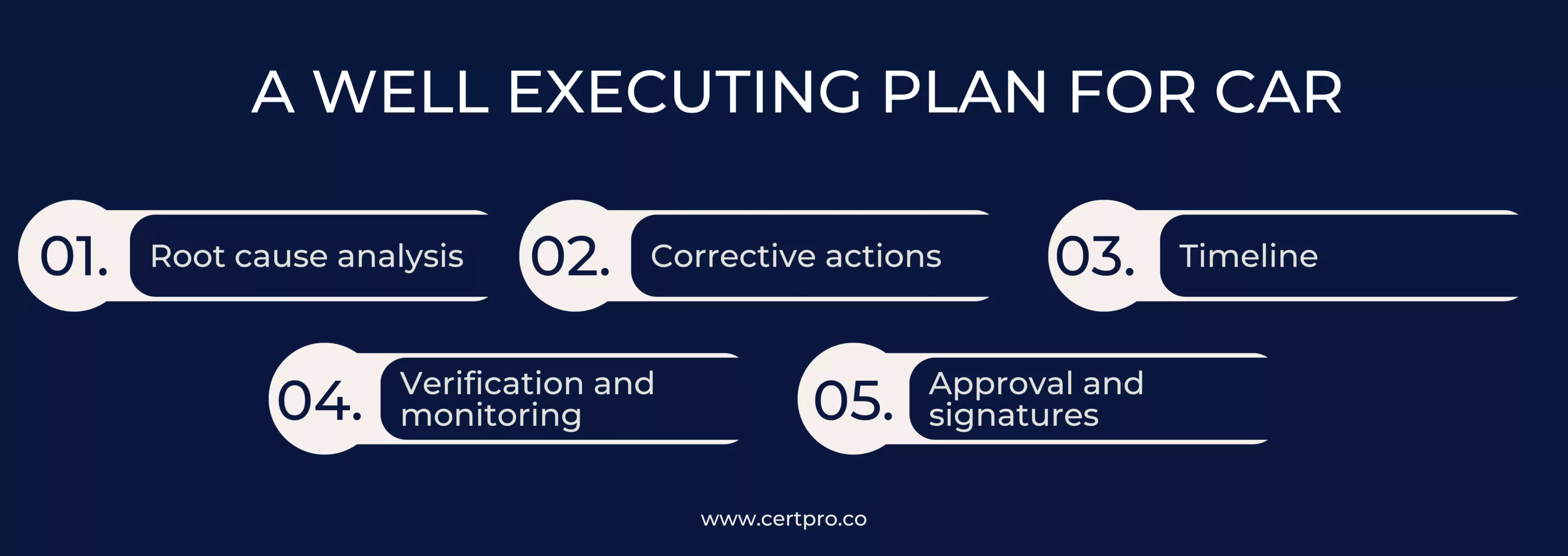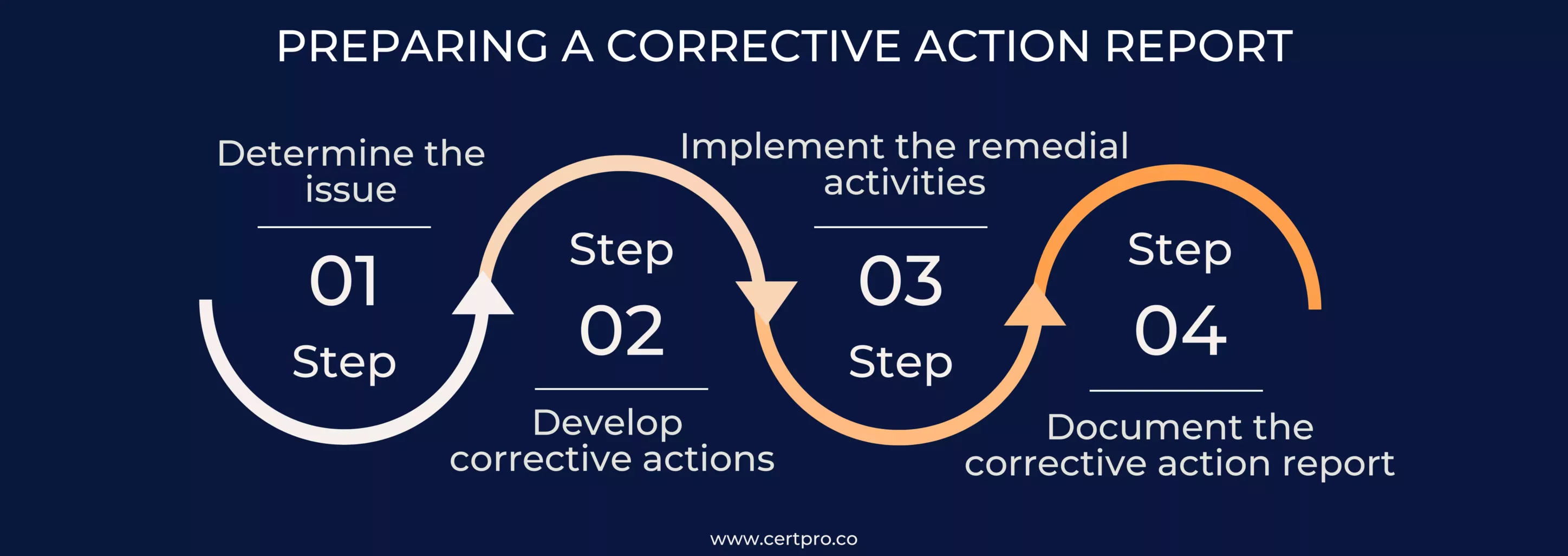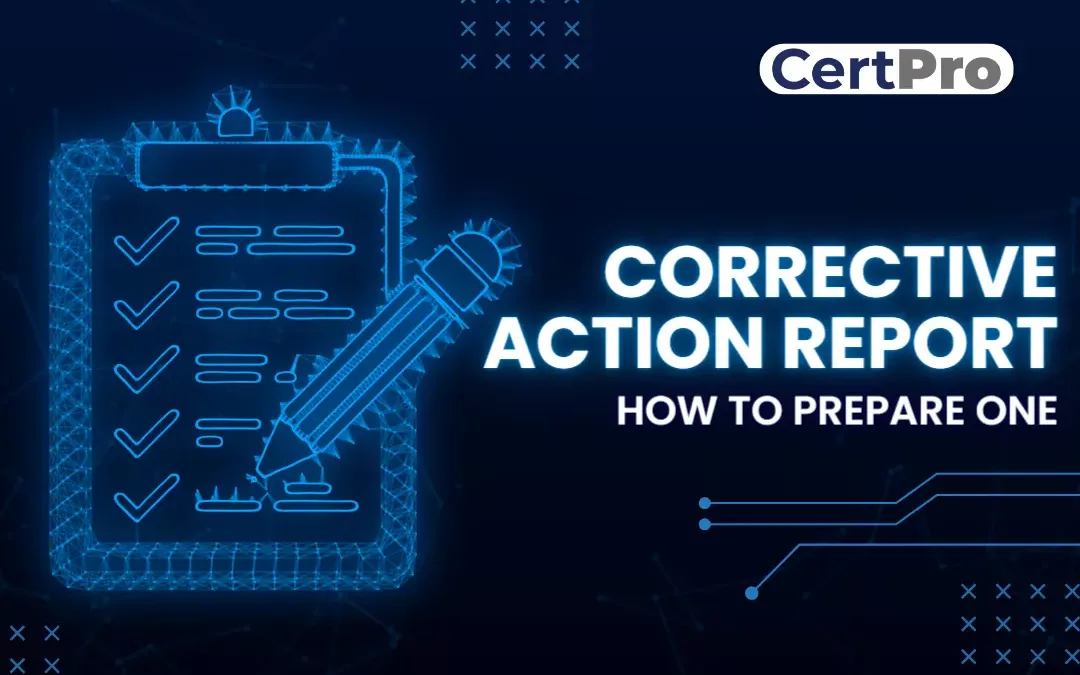Issues and nonconformities are unavoidable in any organization. Whether they are the result of a quality issue, a process flaw, or a customer complaint, these incidents can have a significant impact on operational effectiveness and customer satisfaction. Organizations frequently use a methodical methodology known as “Corrective Action Reports” (CARs) to address and resolve these problems efficiently.
A Corrective Action Report is a critical tool that assists businesses in identifying the core causes of difficulties, implementing corrective measures, and preventing their recurrence. CARs enable continuous improvement and promote organizational performance by recording the problem, understanding its underlying causes, and articulating the activities done to fix the situation. In this blog will go over the specifics of a CAR and give a step-by-step tutorial on how to efficiently construct one. Organizations may improve their problem-solving capacities and establish a culture of quality and improvement by knowing and employing this essential tool.
WHAT IS A CORRECTIVE ACTION REPORT?
A corrective action report (CAR) is a document that details the activities taken to address and remedy a recognized problem or nonconformity within an organization. It is a methodical technique to determine the core cause of an issue and devise a strategy to prevent its recurrence in the future.
A CAR’s objective is to provide a systematic framework for finding, assessing, and correcting problems in order to improve processes, systems, and overall performance. It usually starts with a description of the problem, including data like when and where it happened, the impact it had, and any urgent steps taken to reduce its repercussions.
The CAR then uses approaches such as the 5 Whys or cause-and-effect analysis to determine the root cause of the problem. Coming up with a corrective action plan can be helpful. This aids in determining the underlying causes of the problem, whether they are connected to human error, equipment failure, procedure inadequacies, or other issues.
A WELL EXECUTING PLAN FOR CAR
A Corrective Action Report (CAR) plan is a document that explains the methods and procedures for addressing and resolving reported issues, problems, or non-conformities inside a company.
The goal of this report is to provide a disciplined and methodical approach to problem solving and process improvement. It assists companies in identifying the fundamental causes of problems, implementing effective remedial steps, and preventing similar difficulties in the future.
Firstly, identify the problem and explain the nonconformance or issue in full, including specifics such as what went wrong, when and where it occurred, and any relevant supporting information or proof.

A typical Corrective Action Report contains the following details:
1. Root cause analysis: Determine the fundamental cause(s) of the problem using root cause analysis. This entails looking into and examining the causes that led to the noncompliance. The root cause analysis assists in determining why the problem happened and in preventing similar problems in the future.
2. Corrective actions: Describe the precise steps taken to resolve the problem. This may involve adjustments to processes, procedures, training, or any other actions required to prevent the issue from recurring. Corrective activities should be well-defined, attainable, and aimed at resolving the fundamental problem.
3. Timeline: Establish a timetable for taking remedial measures. This helps to guarantee that the essential procedures are performed in a timely manner and that the problem is fixed.
4. Verification and monitoring: Describe the procedures used to assess the efficacy of remedial efforts. Monitoring, inspections, audits, or other assessment tools may be used to confirm that the problem has been fixed and that the actions taken have been effective.
5. Approval and signatures: Obtain approvals and signatures from key stakeholders such as supervisors, quality managers, or other responsible parties. Signatures show that the Corrective Action Report and its conclusions have been acknowledged and accepted.
PREPARING A CORRECTIVE ACTION REPORT
Recording and describing the steps taken to address a problem or nonconformity and prevent its recurrence results in a corrective action report. Here’s a general approach to writing a report:

1. Determine the issue: Define the issue or nonconformity that has to be solved. Describe the problem in full, including its impact and any supporting facts or statistics. Investigate the problem’s underlying causes to find the root cause(s). To discover relevant elements, employ approaches such as the 5 Whys, fishbone diagrams, or cause-and-effect analysis.
2. Develop corrective actions: Propose specific corrective measures based on the root cause analysis that will solve the problem and avoid its recurrence. Each remedial action must be specific, quantifiable, and time-bound. Consider the following elements:
What steps must be taken to fix the problem?
Who will be in charge of carrying out the actions?
What resources or assistance will be needed?
What is the expected completion date?
3. Implement the remedial activities: Make certain that the suggested corrective measures are carried out. Monitor implementation progress and handle any issues or roadblocks that occur.
4. Document the corrective action report as follows: Formalize all pertinent material and results into a report. Include the parts listed below:
- Problem description: Provide a short explanation of the problem, remedial measures taken, and their consequences in the executive summary. Describe the problem or nonconformity in detail, including the impact and supporting evidence.
- Analysis of the underlying causes: Explain the fundamental reasons discovered throughout the analysis.
- Corrective actions: Describe the exact steps taken to resolve the issue, including responsibilities, resources, and dates.
- Implementation specifics: Describe how the remedial activities were carried out and any difficulties encountered.
- Effectiveness assessment: Examine the effectiveness of the remedial activities and their impact on the issue’s resolution.
After the report has been authorized, continue to monitor the situation to ensure the problem does not reoccur. Monitor progress and ensure that corrective interventions continue to be effective.
Keep in mind that the structure and content of the corrective action report may differ based on your organization’s needs and industry norms. Adapt the preceding stages and sections to meet the needs of your company.
KEY POINTS TO REMEMBER
Finally, a Corrective Action Report (CAR) is a formal document used inside an organization to identify and rectify non-conformances or concerns. It takes a systematic approach to problem resolution by documenting the issue, doing a root cause analysis, executing remedial activities, and assessing their efficacy.
The CAR is a detailed record of the problem, its resolution, and the efforts made to prevent it from happening again. It encourages organizational responsibility, openness, and continual development. Organizations may successfully resolve problems, identify and remove fundamental causes, and improve overall quality and efficiency by following the procedures specified in a Corrective Action Report.
Organizations may develop a culture of learning, problem-solving, and proactive improvement by using Corrective Action Reports. It guarantees that concerns are addressed in a methodical manner, preventing their recurrence and encouraging a more robust and resilient operation. Finally, the CAR assists firms in improving their quality, customer happiness, and organizational excellence.
FAQ
How long should you keep a Corrective Action Report?
Depending on corporate rules and regulatory constraints, the retention term for CARs may vary. It is best to keep CARs for a long enough length of time to ensure access to historical data, references for audits, and trend tracking over time. Based on their unique needs and regulatory responsibilities, organizations should decide the right retention duration.
Is it true that Corrective Action Reports apply to all industries?
Cars may be employed in a variety of businesses and areas. They are especially widespread in industries that place a premium on quality control, such as manufacturing, healthcare, aerospace, and food processing. However, depending on the sector and organizational requirements, the particular content and methods may differ.
How do Corrective Action Reports play a role in increasing customer satisfaction and trust?
CARs reflect an organization’s commitment to recognizing and resolving issues as soon as possible. CARs improve product or service quality by executing corrective measures and preventing recurrence, resulting in higher customer satisfaction. This, in turn, fosters consumer trust and loyalty, favorably improving an organization’s reputation.
Corrective Action Reports: Can they help with regulatory compliance?
A big Yes, CARs are frequently required to meet industry standards, laws, and quality management systems. Organizations may demonstrate their commitment to achieving regulatory standards and maintaining compliance by following a disciplined strategy and recording remedial actions.
What exactly is a Corrective Action Report (CAR)?
A CAR is used to capture and monitor the facts of a nonconformance or issue inside an organization, including the activities taken to address and fix the problem. It aids in the identification of root causes, the implementation of corrective actions, and the prevention of recurrence of problems.

About the Author
MOHAMMAD YASIN
Mohammad Yasin, Regional Manager in Jordan, is a cybersecurity specialist. With a dedicated focus on securing digital landscapes, he brings extensive experience in compliance and strategic cybersecurity measures to the forefront.
AI SECURITY: UNDERSTANDING THREATS AND COMPLIANCE SOLUTIONS
Artificial Intelligence continues to grow and become more relevant in workplaces. Customers widely use it to handle and market products. Organizations are desperately using AI for their businesses and ensuring that the AI systems comply with the new rules and...
HOW DOES THE NIST CYBERSECURITY FRAMEWORK FUNCTION, AND WHY IS IT IMPORTANT?
Emerging cyber threats make cybersecurity an essential consideration for organizations handling and managing data. In this regard, the NIST cybersecurity framework applies to improving your cybersecurity program. It is a set of guidelines that helps improve your...
UNDERSTANDING ISO 42001: A GUIDE FOR RESPONSIBLE AI MANAGEMENT SYSTEMS
The invention of artificial intelligence (AI) has changed the operational processes of many industries. However, the rapid growth of technology increases ethical, security, and privacy-related concerns. Therefore, the International Organization for Standardization...




